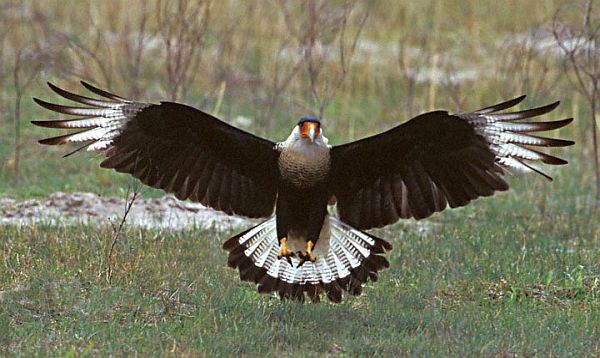Nova Scotia, Canada - A wayward visitor thousands of kilometres from home has the Nova Scotia birding community all aflutter. A Crested Caracara ó the official bird of Mexico ó was spotted feasting on a deer carcass across the road from Lawrencetown Beach.
Birdwatchers have flocked to the community, outside Dartmouth, ever since, hoping to catch a rare sight of the red-faced raptor ó slightly smaller than an osprey, with a huge hooked bill and wingspan of more than three feet.
It is the first time this member of the falcon family has been spotted in Nova Scotia, said bird enthusiast Blake Maybank, moderator of the Nova Scotia Rare Bird Alert. And it is only the second sighting confirmed in Atlantic Canada ó the first being a young bird spotted in New Brunswick about 15 years ago.
"Iíve been birdwatching since we moved here in 1987 and I cannot recall any one time in the past seeing quite so many birdwatchers here looking at one bird," Maybank said. "Itís a very showy bird. Itís a very attractive bird."
A birdwatcher who thought he had seen the caracara contacted him Saturday and a notice was posted to the 450 members of the rare bird alert, he said.
Word spread like wildfire, and within hours, dozens of people were already at the beach with cameras, binoculars, and telescopes. Even more showed up around sunrise the next day, and there were reports the bird was spotted again as well, Maybank said.
The raptor, which will scavenge meat and hunt for live food, has caused "just about as much ado as possible among birders," said Hans Toom, a Portuguese Cove nature photographer who has put his images of the bird online at hanstoom.com.
"Pretty much everyone has been trying to find it," Toom said. Crested caracaras normally are found in the southern part of American states that border Mexico, Maybank said. There is also a small Florida population.
It is difficult to say what brought this one so far north. Hurricanes or gale winds arenít to blame, so "why itís up here is beyond anyoneís understanding," Toom said. "It just doesnít make any sense."
But there have been other unusual sightings of the species reported this year in New Jersey and Delaware. Maybank warned anyone who hopes to catch a glimpse to be patient. Some folks have waited hours before seeing it, he said.


